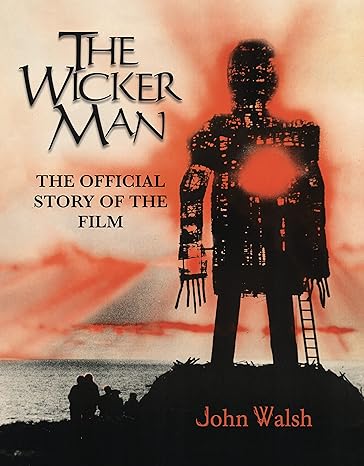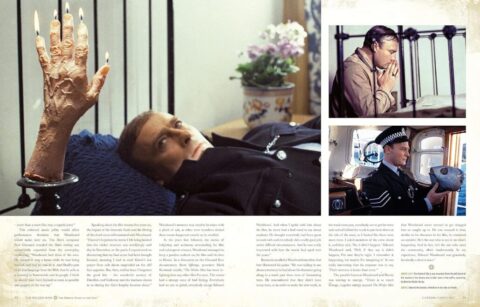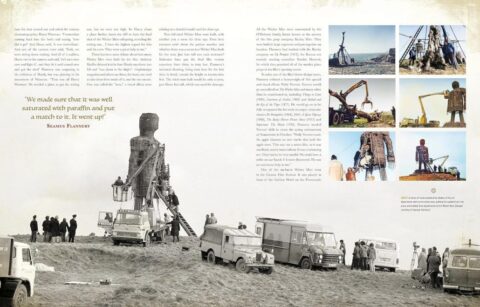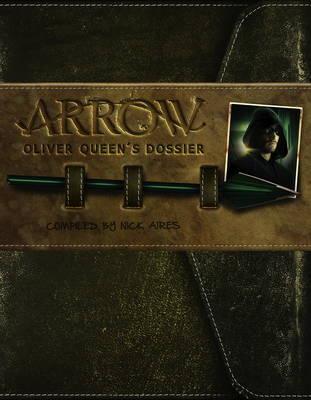PUBLISHED BY TITAN BOOKS
192 PAGES
AVAILABLE IN HARDBACK

“It was seven frantic weeks of sleepless nights, heavy socialising, fantastically hard work and a kind of wartime Blitz camaraderie” [Edward Woodward]
“The Wicker Man was, in the end, horrifying, but not what I’d call a horror film. It was about growth, not decay” [Christopher Lee]

And so I finally get my mitts on John Walsh’s book on the making of the film regarded by many as the finest British horror film ever made. For me, The Innocents just about beats The Wicker Man while The Devil Rides Out is more of a personal favourite, but there’s no doubt that Robin Hardy’s 1973 picture is a true classic, and a movie which literally had me screaming at the TV screen when I first watched it as a younger teenager, in a version which I believe was slightly different to the three main incarnations of this masterpiece. Why was I doing such a thing? [SPOILER FOR THOSE VERY FEW READERS WHO’VE NOT SEEN “THE WICKER MAN”. Because I desperately wanted Sgt Howie to break free or be rescued in the nick of time, and it soon became apparent that neither of these things were going to happen. SPOIILER END]. I really didn’t like that ending, though I loved what came before. It was a very slow film, “slow” not really being something that I liked much back in the day, but had an extremely disquieting atmosphere unlike any other motion picture I’d seen previously, and the detail and the premise of a rigid Christian at large in this sexual pagan culture fascinated me. Over the decades a lot has been written about The Wicker Man, with certain stories such as the negative for the uncut version being thrown out and becoming landfill for the M3 helping to propel it into legendary status. There have even been several previous books. It truly seems that John Walsh, author of “Making Of” books about Flash Gordon, the Dr Who And The Daleks twosome, Escape From New York and Conan The Barbarian, had his work cut out here. However, while I haven’t read any of said previous books except the last, I can still say that Walsh has more than fulfilled expectations here with a simply fantastic tome which succeeds on every level.
How fantastic is it? Well, I read it over three days. Honestly. I began it on Friday evening, continued on Saturday evening, and finished it yesterday lunchtime leaving me plenty of time within which to do this review. I rarely read a book, even if it’s about movies or a movie [which constitutes the majority of my non-fiction reading], that quickly, I usually need to stop after a couple of hours, but I couldn’t stop this time – and no, I’m not being incentivised to say this, nor feel that I have to say such stuff so I will have the opportunity to review similar offerings from Walsh and Titan Books, though how they will be able to top this one I don’t know. As with the others, it’s simply a hugely attractive offering to just leaf through and look at, due to the simply incredible array of stills and production material that Walsh has been able to compile, thanks to the likes of StudioCanal and Film Finances [the completion bond company which essentially ensured that The Wicker Man got made], not to mention the private collection of production designer Seamus Flannery which contributed some of my favourite pictures, ones which feaature the Man himself, from photographs detailing in stages both his building and his burning, to a large drawing of the Man’s design, something only previously seen in very small form. All this is well laid out and, even though some of the pictures are very large, taking up almost two pages, they never becomes intrusive or detracts from the text if that’s what you want to focus on, and the text itself is easy to read and with a really interesting fact or possible fact [there are a lot of conflicting viewpoints which is great] on virtually every page. It helps conaiderably that Walsh has been able to secure a lot of interviews, including even Britt Ekland, who tends not to participate in such things, especially for a film that she’s not keen on!
After an introduction by Walsh where he says how he’s been able to use material previously unseen, we move on to a chapter on David Pinner, who wrote the novel on which The Wicker Man was based, Ritual, making much use of an interview carried out by Walsh with him. Here we have the first of a great many wonderful stories, some of which will be totally new to readers. Pinner says how he was writing Ritual while acting in The Mousetrap; at one point he was so focused on what he was writing that he forgot to come out on stage and murder an actress. Said actress ended up strangling herself instead. And do many people know that Michael Winner was interested in filming it? Thank goodness that never happened. Walsh provides a good summary of the novel though doesn’t reveal its ending which is not the same as the film’s ending but is apparently also shocking. A str0ng case is made by some for Pinner not being given enough credit, it’s mostly all about Shaffer and Hardy. Winner is currently developing a film based on his sequel novel The Wicca Woman. Then follows a very interestng chapter on the historical side of things, with a lot of input from a Dr David Anwyn Jones, who says that wicker men may well have been used in past times but there’s no real evidence of this. We’re reminded of how un-noble the Crusades were, as well as being told that the film actually gives paganism a bad name, which is something I’ve admittedly never really thought about. And then it’s on to the movie stuff.

As has become customary, Walsh then goes through the main cast members, making much use of new and old interviews, then the key members of the production team before detailing the production itself. There’s so much for the hardcore fan, the casual fan and even just the general movie lover to enjoy here. Woodward, on learning of the love that Quentin Tarantino [who also has a private copy of the Woodward-starring Callan The Movie[!] has for Woodward’s Secret Target: “Well, you must tell your friend he is very strange indeed”. Co-producer Georges Pinches, who was married to Ingrid Pitt, threatening to ruin her career after a row and being a man of his word. One of the local extras Mark Sunderland still being owed money by Woodward for cigarettes. The cast having to suck ice cubes between takes to stop their breath showing. Walsh’s seeming knack for being able to secure interviews with people who don’t normally do interviews perhaps reaches its peak with his chapter on Ekland, who tells of how she wasn’t liked on set with only Diane Cilento befriending her, as well as explaining the complex business concerning her and her body double doing her character’s dance. And he allows Michael Dooley, one of the two British Lion heads who got editor Eric Boyd-Perkins to shorten the film for distribution as a supporting feature to Don’t Look Now, to speak his side of the story. People tend to forget that few liked The Wicker Man at the time, with distributors turning it down and producers not convinced of the commercial value of what was indeed quite an odd film. Was Christopher Lee right to slag him off as much as he did? His claim that the original negative was destroyed deliberately does seem flimsy, and the edits he complained about most all featured him. Oh well. I still love him.
Pleasingly, different viewpoints are often presented and honest opinions are plentiful. Hardy often gets criticised. Flannery especially goes for this “unpleasant nasty little man” who once complained that the decor was unrealistic. Flannery’s reply is classic: “It’s a bullshit distinction. This was exactly the kind of intellectualisation that, with Robin Hardy, would always get in the way. Do you really think someone watching The Wicker Man would have stood up in the cinema and shouted “Hang on, that jhfurniture is a hundred years too old” “.Along with all this is a treasure trove of illustrations of various kinds. All the well known stills are present, as they should be, but there are also loads of less familiar ones, including some from deleted scenes that were shot but which still haven’t been found and probably never will be; the one of Pitt’s librarian trying to seduce Howie is probably the one I’d like to see most. Then there’s all that behind the scenes material, and even some pages of the script, sometimes with notes. The music is dealt with in detail. Of course there’s much about the re-editing to form the UK theatrical version, but Walsh also clarifies some things concerning the film’s rebuilding and resurrection; a huge shout out to John Allan Simon here, an unsung hero really. I’ve been disappointed for some time that the Final Cut is missing several minutes of material in the Director’s Cut, and many fans are the same, but that’s because the sole print of the Director’s Cut, owned by Roger Corman, became lost with only a one-inch video tape surviving which was okay for TV and video but definitely not for successive formats. An extensive selection of artwork inspired by the film concludes the book; they even include a spoof advertisement, though my favourite part of the latter stages of the book is an extensive chart detailing the exact differences between the three main versions of the film.
Throughout, we get various potential explanations as to why The Wicker Man remains so beloved. One thing that struck my mind the last time I watched it, which is indeed mentioned, is that it hasn’t really dated, it could almost pass for a new movie. As he did in the Conan book [I don’t know about the others], Walsh occasionally repeats material, including quotes, a sign perhaps of how fast these books are being turned out, and shouldn’t the Cilento bit be in the section on supporting performers, not as part of the chapter on producer Peter Snell? But these very minor flaws are really the only criticisms that I have about this terrific book which is simply a must buy whether you’ve had decades of experience with this endlessly beguiling film or, like poor Howie, you were until only recently a Wicker Man virgin.
Rating: 














Be the first to comment